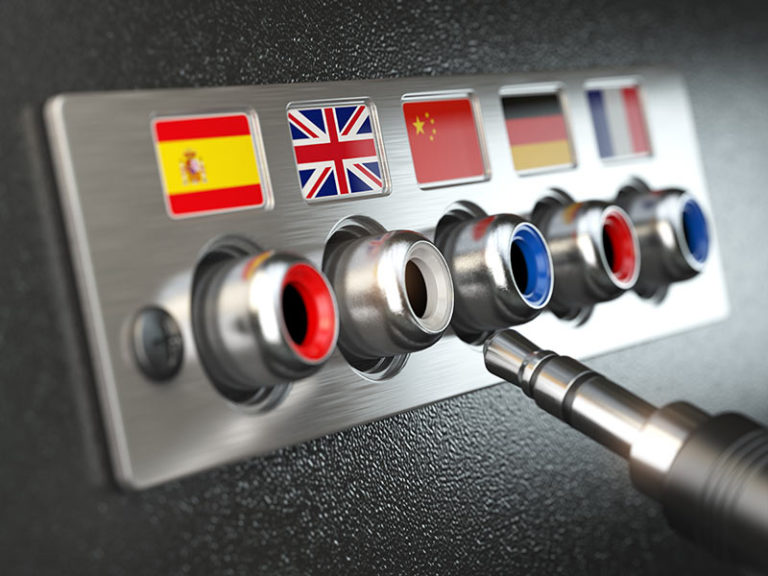Consecutive vs Simultaneous Interpreting: A Guide
Interpretation has been around longer than translation.
Long before writing was invented, conversations were translated orally (i.e., interpretation) by third parties that knew both languages.
Since 1945, it has split into two main kinds: consecutive and simultaneous interpretation. (See why this year is significant below…)
Though there is a crossover between each type of interpretation, there are some big differences, too.
Let’s take a closer look at these.
What is interpreting?
Interpreting is essentially spoken (/oral) translation.
It is called interpreting (and not oral or spoken translation) to distinguish it from written translation and because the interpreter must interpret and express meaning.
To a degree, interpreters explain the meaning of what has been said rather than give the word-for-word quote a translation of it.
Interpreters may also need to deal with a wide range of idiosyncrasies by speakers, including (but not limited to):
- Fast speaking
- Use of ‘untranslatable’ slang or other culturally specific references
- Inarticulate phrasing
- Heavily accents
- Purposeful obfuscation
Unlike translation, interpreting is done on the spot and without the aid of dictionaries, translation software, a review or quality assurance process, etc.
What is consecutive interpretation?
Consecutive interpretation (CI) is an oral translation that takes place immediately after a speaker pauses between segments of speech.
The precise length of each segment interpreted is usually at the speaker’s discretion. It can range from a few seconds to a few minutes.
In in-person settings, the interpreter stays near the speaker and often takes notes whilst the latter speaks.
How does the audience experience consecutive interpretation?
The audience at an event that features consecutive interpreting services should receive a clear explanation of what speakers say throughout the proceedings.
There will be a delay between when a speaker says something and when the interpreter gives their summary. This can cause a slightly disjointed and stop-start effect on interactions between speakers and the audience.
This makes it particularly unsuitable for most TV shows or internet videos, for example, where audiences may become impatient with half of the content (the half they don’t understand).
Lost in interpretation…
If some of the audience also understands the language being interpreted, there might be a somewhat split reaction to speakers.
For example, if the speaker makes a humorous comment, those that directly understand it in the source (i.e., original) language might laugh at it immediately.
But those who only understand the interpreter’s version will not only have a delayed reaction, they might also laugh less – or not at all!
After all, the full impact of jokes might be lost in translation for linguistic or cultural reasons…
People skills
Consecutive interpreters may find themselves needing to manage personal interactions with discretion.
In some cases, this may mean significantly simplifying what is being said in order for the listener(/s) to better understand it. This was famously conveyed for comic effect in a scene in the 2003 movie Lost In Translation.
They might also have to manage tense and even awkward situations. When Chinese leader Mao Zedong visited the USSR in 1950, things weren’t easy for the interpreters:
In the limousine… the Chinese interpreter invited Stalin to visit Mao.
‘Swallow your words!’ Mao hissed in Chinese to the interpreter. ‘Don’t invite him!’ Neither of the titans spoke for the entire 30-minute drive….
At the banquet, the two giants barely spoke: ‘sporadic exchanges’ subsided into ‘endless pauses’.
It was tough for the USSR’s interpreters, too. When he took over as then-minister Molotov’s interpreter, Valentin Berezhkov knew that his four predecessors had been shot…
What is simultaneous interpretation?
Simultaneous interpretation (SI) is an oral translation that takes place as the speaker who is being interpreted is speaking.
In other words, it is (more or less) a form of real-time oral translation. Strictly speaking, it isn’t truly simultaneous because interpreters obviously need seconds or fractions of seconds to hear, process and repeat what’s being said.
It typically involves the help of a sound technician and specialist technology, including microphones, headsets (for both the interpreters and audiences), and soundproof booths.
It is an intense task that requires full concentration. So at least two interpreters (‘booth partners’) work as a team, in short, approximately 15-minute shifts.
When simultaneous interpretation was invented: The Nuremberg Trials
Simultaneous interpretation as we know it was invented in 1945, for the trials of defeated Nazi officials.
The trials, which laid the foundation of modern international criminal law, were set up by the International Military Tribunal. Multiple interpreters were needed to cover the four languages involved (English, German, French and Russian).
Prior to the trial, a consecutive interpreter was usually used for high-level translation. But French-American language specialist Léon Dostert came up with the idea of simultaneous interpreting using headsets in order to manage the trials’ complex requirements.
How does the audience experience simultaneous interpretation?
Audiences at events that use simultaneous interpreting services are given headsets at events.
These give them a direct line to the voice of a simultaneous interpreter interpreting what’s being said by speakers as they say it.
The ‘Flow’ of simultaneous interpreting
The ‘flow’ of simultaneous interpretation will vary according to the interpreter, speaker, subject matter, etc. And it might be interrupted or influenced by the following:
- Brief pauses
- Slight tones of struggle in the interpreters’ voice
- The switching of interpreters (approximately every 15 minutes)
- The sound of the original speaker creating a background noise effect
However, overall, the general impression will be one or relatively seamless interpretation given in real-time.
Try out how simultaneous interpreters work for yourself
To get an idea of how difficult simultaneous interpreting is, try and listen to someone speaking in English in a video or audio file whilst simultaneously summarising what they say aloud in slightly different words…
Consecutive vs simultaneous interpretation: 5 differences
1. Situations used
There are some occasions when event organisers can choose between using consecutive vs simultaneous interpreting services. But there are others where one or the other is the only practical choice.
Large or important events that are likely to feature a lot of speaking in a language unfamiliar to the audience are more suited to simultaneous interpreting. Its use enables these events to be significantly more effective at condensing content into allotted times.
By contrast, consecutive interpreting can add a human touch to proceedings. It is suited to smaller or more sociable events. It’s especially useful for events that require any kind of activities that resemble networking.
In short, consecutive interpreting is better suited to meetings whereas simultaneous interpreting is better for conferences.
Example of hybrid interpretation 1: The United Nations (UN)
The UN is the world’s largest international organization. It has 193 member states and 6 official languages – Arabic, Chinese, English, French, Russian, and Spanish.
This means that there are 30 potential language combinations to be interpreted with. But on top of this, member state representatives can also bring their own interpreters to cover their native language if they need or want to.
UN activities are related to a range of topics, from trade to security. Interpreters at these must meet the highest possible standards, as any mistake can have extremely serious consequences. They are required to be able to speak at least three of the official languages.
UN events range from one-on-one meetings using one or two consecutive interpreters, to large sessions covered by tens of simultaneous interpreters in booths.
Example of hybrid interpretation 2: The UFC
The UFC is a famous mixed martial arts (MMA) promoter. It regularly hosts bouts between martial artists from different countries.
Fights take place over 5-minute rounds with 1-minute rest periods. During the latter periods, simultaneous interpreting is used to capture the instructions of combatants’ cornermen for broadcast audiences.
And at the end of fights, consecutive interpreting is used for fighters’ speeches to both the live and broadcast audiences.
If you watch a UFC event, it becomes clear that consecutive interpreting between rounds and simultaneous interpreting after bouts would both be completely impractical!
Remote interpreting
Remote interpreting is interpreting that takes place with either the speakers or the interpreters at different locations.
It sometimes requires interpreters to travel to designated locations to interpret from a soundproof booth with a booth partner, headphones, etc.
Other times, the interpreter simply interprets from home in joint online meetings.
2. Effect
Humans are social animals and as such we are (mostly) sensitively attuned to different contexts and situations.
Simultaneous and consecutive interpreting each creates a different effect or atmosphere for audiences and speakers.
Simultaneous interpreting: more formal and information-led
Simultaneous interpretation creates a more formal and impersonal atmosphere. Interpreters sit in booths out of sight from most guests. Their voices contain less inflexion and nuance as they quickly and efficiently cover what is being said.
This atmosphere is suited to formal, fast-paced and information-rich events.
Consecutive interpreting: More nuanced and (potentially) interactive
Consecutive interpretation requires interpreters to be in or next to the centre of attention, which enables the audience to read their facial expressions and body language. Speakers might even interact directly with interpreters.
Is consecutive or simultaneous interpreting more accurate?
Consecutive interpreting is ultimately more accurate than simultaneous interpreting. This is because the interpreter has more time to interpret and even correct (their own) and clarify (the speaker’s) points.
The extra time and physical proximity they gain also enable them to better express nuance, emotion and hints by the speaker. Their interpreting can at points even resemble voiceover actors rather than the newsreader-like tone of simultaneous interpreters.
An even more accurate version than both of these types of interpretation would be to have the original speakers’ words transcribed and then translated. However, this process is not suitable to live meetings or events.
3. Difficulty
Generally speaking, consecutive interpreting is more difficult to do than consecutive interpreting. It requires a more technical set-up (see below, ‘4. Equipment’), multiple interpreters, and a smaller margin for error than simultaneous interpreting.
For example, if simultaneous interpreters did not understand a crucial term used by a speaker, they simply would not be able to accurately render most of what was being said.
In the same situation, consecutive interpreters would have more time to work out the term and could even ask the speaker directly.
That said, the people skills aspect of consecutive interpreting should not be overlooked. The ability to understand social cues, read emotions and nuanced speech, etc., all help make a skilled consecutive interpreter.
4. Equipment
Consecutive interpreting may or may not require the use of equipment, depending on the size of the meeting or event. If it does, interpreters can simply use a microphone as other speakers do.
Simultaneous interpreting requires a lot more specialist equipment. They require soundproof booths, different headsets for the interpreters and audience, and microphones for the speakers and interpreters.
All of this needs to be set up before events by specialist technicians. It can be particularly difficult in situations where rooms have unusual dimensions or acoustics.
5. Cost
There is a big cost difference between consecutive and simultaneous interpreting.
Simultaneous interpretation is usually more expensive than consecutive interpretation. Ballpark figures for the average costs are:
- Simultaneous interpretation usually costs $750 – $1200 per interpreter per day (a minimum of two is required)
- Consecutive interpreting usually costs about £500 per interpreter per day (one interpreter is usually ok)
However, as our article on the costs and profits in the translation industry discussed, giving average cost estimates for language services can be difficult.

Final costs depend on several conditions, such as the following:
1. Language pair
Different language pairings vary in cost. It’s essentially a supply and demand issue. The rarer the language pairing, the higher the cost.
2. Experience of the interpreter
Interpreters vary in their experience and skill levels. The resulting price difference for this usually varies less for simultaneous translators.
However, for consecutive interpreting, you might be able to find anyone from an inexperienced language student to a high-level professional interpreter – and the cost will vary accordingly.
3. Minimum charges
Except in cases of remote interpretation, interpreters need to travel to and from assignments.
This means that the number of assignments they can fit into a day is limited. So the vast majority have a minimum day – or in some cases half-day – charge.
This means that even if you only need them for an hour, you will likely have to pay for more than that.
4. Travel & accommodation expenses
Interpreters require travel and accommodation expenses on top of their regular fees. For projects extending over half a day, this will often include food expenses, too.
5. Copyright
An interpreter’s work is their own intellectual property. If you are planning on recording or broadcasting an event, then you need to have the interpreter’s written consent. This may require an additional fee, which you can negotiate with the interpreter.
How does the interpretation business model work?
Consecutive and simultaneous interpreters usually work as freelancers in the language service industry.
On occasion, some might directly through a language service provider (LSP). Most of the time, they find work through LSPs and their own direct clients (or a mixture of both).
In some cases, LSPs use their own staff to interpret. However, this model is relatively rare.
Either way, it is more straightforward to hire interpreters through LSPs because they can vet, advise on and organise interpreters on the client’s behalf. LSPs will mark up the fee to cover their management and admin costs, but this is arguably well worth the price in many cases.
For companies regularly using interpreting services, it makes sense to form direct relationships with interpreters and sound equipment suppliers. This will save on costs in the long term.
How do the different types of interpreters work?
Generally speaking, most interpreters capable of simultaneous interpretation also work as consecutive interpreters. But many who are capable of consecutive interpreting don’t also work as simultaneous interpreters.
And both kinds often use their language skills to do regular translation work, too (as freelancers).
Will machines replace interpreters?
As machine translation develops, many believe that, like translators, interpreters will eventually be replaced by machines.
Meta (formerly Facebook) announced recently that they are making progress in spoken translation tools.
If these tools do replace interpreters, it may be the case that they replace simultaneous interpreting first. This is because of the more dramatic cost-savings it will make.
But also, the need for the ‘human touch’ (discretion, social interaction, etc.) needed in consecutive interpreting will be harder to achieve with machines.
Conclusion
Simultaneous and consecutive interpreting are types of oral translation.
Though there are similarities, each type of interpretation is generally suited to different situations.
Simultaneous interpreting (SI) is generally used at large, information-heavy events. It is efficient because it takes place more or less in real-time.
Consecutive interpreting (CI) is generally suitable for smaller events with relatively less information sharing. When the speaker has paused, the interpreter speaks.
From a technical standpoint, simultaneous interpreting is more difficult and expensive. Multiple interpreters and equipment such as soundproof booths are usually needed.
Working with an LSP is the easiest way to hire an interpreter. This is especially useful for short-term and one-off projects. However, if you are regularly using interpreters’ services, directly forming a relationship with one or more of them will be more efficient.






